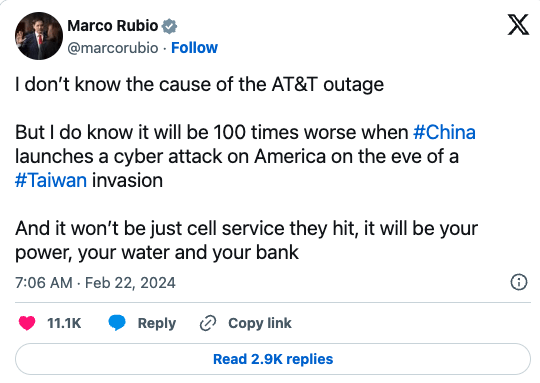
Solar Flares, Cellphone Outages, and Cybersecurity Concerns
Table of Contents
- The ATT Outage: A Timeline and Response
- Understanding Solar Flares
- The Role of Electromagnetic Fields
- The World of Telecommunications and Man-Made EMFs
- Societal Impact and Emergency Preparedness
- The Broader Context of Cyber and Space Security
- Navigating the Complex Landscape of Telecommunications Security
- Securing Our Digital Lifelines
- Related Posts
In a world reliant on technology, the recent AT&T outage presents a fascinating case study at the intersection of natural phenomena and human innovation. The official story is that Americans have reported nationwide cellular outages from AT&T, Cricket Wireless, and other providers on February 22, 2024. While the official cause remains shrouded in mystery, the speculation surrounding solar flares and their impact on telecommunications infrastructure invites a more nuanced conversation.
The ATT Outage: A Timeline and Response
As reported on February 22, 2024, the AT&T outage affected thousands, with service disruptions peaking at around 72,000 reports according to Downdetector. The company’s swift response managed to restore 75% of the network by late morning, yet the lack of clarity on the cause adds layers to the discussion. AT&T’s official statements and updates serve as primary sources of information for those following the developments.
The network quickly claimed the cause to be “solar flares” that caused a disruption in the Earth’s electromagnetic field to target AT&T in North America.
Update: February 23, 2024
“Based on our initial review, we believe that today’s outage was caused by the application and execution of an incorrect process used as we were expanding our network, not a cyber attack,” AT&T said in a statement on Thursday evening.”
In their statement, the network emphasized their ongoing commitment to understanding the full scope of the outage, while ensuring they continue to provide the high-quality service their customers expect and deserve.
Understanding Solar Flares
Although a seemingly false narrative, the solar flare phenomena caught our interest yesterday. Solar flares are massive bursts of radiation from the sun that can disrupt the Earth’s magnetosphere. Scientists monitor these events closely due to their potential to affect satellite communications, GPS systems, and even ground-based technologies. For those interested in the science behind solar flares, NASA’s Solar Dynamics Observatory offers a wealth of data and analysis that sheds light on these cosmic events.
The Role of Electromagnetic Fields
This magnetic field of ours is pretty fascinating. Born from the swirling, molten iron in Earth’s outer core, it stretches far into space, creating a protective bubble called the magnetosphere. It’s here, in this cosmic battleground, that most of the sun’s charged particles are deflected. However, when the sun throws a tantrum (think solar flares or Coronal Mass Ejections), that’s when things get interesting.
During such events, some of the sun’s energy can push past our magnetic defenses, potentially causing what we call geomagnetic storms. Ever seen the Northern or Southern Lights? That’s the beauty of this process in action—solar particles dancing in our atmosphere, creating a light show. But this spectacle also has a flip side, capable of messing with satellites, navigation systems, and yes, even our beloved internet.
The World of Telecommunications and Man-Made EMFs
Enter the realm of non-native Electromagnetic Fields (EMFs). These are the signals and frequencies generated by our gadgets, power lines, and those towering cell towers enabling our binge-watching and endless scrolling habits. Unlike the natural electromagnetic fields that have been around since Earth’s birth, these man-made fields are a recent addition to our environment.
The crux of the matter lies in how these artificial EMFs interact with the natural electromagnetic disturbances from the sun. For instance, a strong solar flare can induce currents in our power and communication networks, leading to everything from minor disruptions to full-blown outages. And with the employment of 5G, we’re introducing even more complexity into this intricate dance.
Societal Impact and Emergency Preparedness
The outage highlighted the critical importance of communication networks for emergency services and personal safety. The response from emergency agencies, urging calm and offering alternatives for reaching 911, underscores the need for robust emergency preparedness plans that account for such technological vulnerabilities. Discussions on platforms like X (formerly Twitter) and statements from city officials, like those from the Mayor of Atlanta, provide real-world perspectives on managing the fallout from such outages.
Rubio’s Stark Warning
Senator Rubio, R-Fla., took to social media to express his concerns, highlighting the AT&T outage as a mere precursor to the catastrophic implications of a potential Chinese cyberattack. Rubio’s hypothetical scenario painted a grim picture of the aftermath of an attack launched with a move against Taiwan. He emphasized that such an offensive would not only disrupt cell service but also target essential services such as power, water, and banking systems, affecting an exponentially higher number of people.

The Broader Context of Cyber and Space Security
Rubio’s warning ties into broader concerns about cybersecurity and the advancing capabilities in space weapons by world powers, including the U.S., Russia, and China. The senator’s reference to briefings on national security threats and space-based weapons targeting U.S. satellite networks underscores the multifaceted nature of modern warfare, where cyber and space domains play critical roles. The creation of the U.S. Space Force under former President Donald Trump is part of a strategic response to these evolving threats.
Navigating the Complex Landscape of Telecommunications Security
The recent AT&T outage due to a solar flare has amplified concerns over the stability and security of telecommunications networks. This incident, whatever the actual cause, sets the stage for broader discussions on the resilience of these networks, especially in the era of 5G communication and extensive data sharing. Below, we look into the complexities of this landscape, addressing key concerns and suggesting pathways for enhancing security and reliability.
5G Communication: Promises and Challenges
Enhanced Connectivity vs. Increased Vulnerability: 5G technology promises faster speeds, lower latency, and the ability to connect more devices simultaneously. However, this technological leap also introduces new vulnerabilities, including a larger attack surface for cyber threats and potential new avenues for EMF interference.
Infrastructure Security: The deployment of 5G involves a dense network of small cells and antennas, raising concerns about the physical security of the infrastructure against natural phenomena and targeted attacks.
Have you paid close attention to how the rollout of 5G has been going over the past few years? As promised, these generational rollouts move quickly and with too little regard for our bodies and the environment’s safety. For more on this, check out our thoughts on The Race to 6G.
Data Sharing in a Connected World
Privacy Concerns: The interconnectedness of devices and the seamless flow of data, while driving innovation and convenience, also raise significant privacy concerns. The potential for unauthorized data access and breaches becomes more pronounced as the volume of shared information grows.
Cross-Border Data Flows: The global nature of data sharing presents regulatory challenges, especially in ensuring data protection across jurisdictions with varying privacy laws.
Recommendation: Implementing stringent data protection regulations and encouraging the adoption of end-to-end encryption can mitigate privacy risks. International agreements on data protection standards could also enhance security in cross-border data flows.
Strengthening Regulatory Frameworks
Adapting Regulations to Technological Advances: Current regulatory frameworks may not fully address the unique challenges posed by 5G and the complex ecosystem of data sharing. Regular reviews and updates to these frameworks are necessary to keep pace with technological evolution.
International Cooperation: Given the global nature of telecommunications and data sharing, international cooperation is key to developing harmonized standards and response strategies for security threats.
Securing Our Digital Lifelines
Today’s AT&T outage, coinciding with solar flare activity, raises a critical question: Are we truly prepared for instability within our technological infrastructure? While it remains to be seen if there’s a direct connection between the solar flares and the outage, this situation undeniably opens up an important conversation about the strength and security of our communication networks.
There’s a real concern about the stability and safety of our telecommunications, particularly with the introduction of 5G and the intricate ways in which we share data. Addressing these issues will require a collective effort. This means stronger policies, innovative technology, active community involvement, and enhanced international cooperation. Together, these steps can build a telecommunications infrastructure that is not only more resilient and secure but also trusted by the wider public.
Moving forward, collaboration will be key. It’s about regulators, tech companies, users, and international partners working in harmony to craft a future where our communication networks can withstand any challenge.
Moments like these serve as reminders that enhancing our digital defenses is not just a task for the experts but a call to action for all of us to rise up and voice our concerns on the matter.




